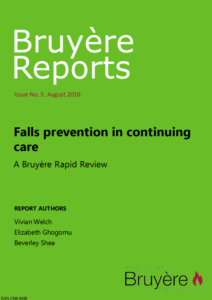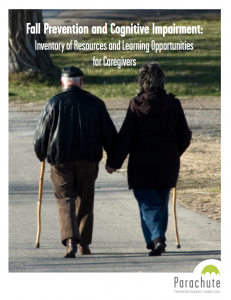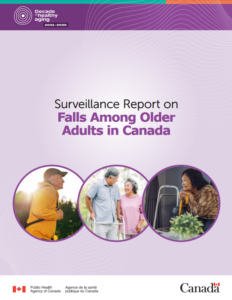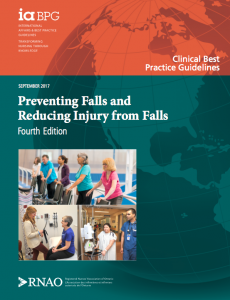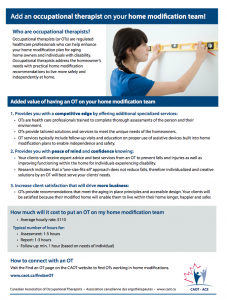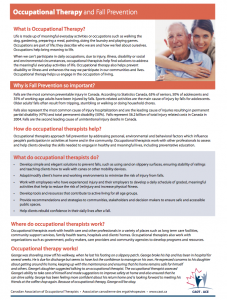Current evidence is essential to understanding the issue. This is your first stop to access key publications and documents to inform your work.
Resources
Reports
-
Alberta Health Services Falls Risk Management Post-Falls Review (2014)
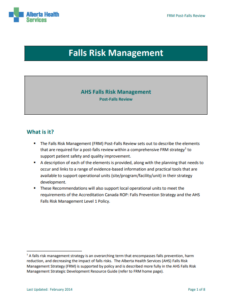
The review describes the elements required for a post‐falls review within a comprehensive falls risk management strategy to support patient safety and quality improvement. A description of each element is provided, along with the planning that needs to occur and links to evidence‐based information and practical tools available to support operational units (site/program/facility/unit) in their strategy development.
426.46 KB PDF
-
Bruyère Rapid Review: Falls Prevention in Continuing Care (2016)
-
Fall Prevention and Cognitive Impairment: Inventory of resources and learning opportunities for caregivers (2018)
-
Falls and Fall Prevention Among Older Adult Indigenous People of Australia, Canada, New Zealand and the United States: A systematic review (2016)
This systematic review presents detailed findings by the four countries represented in this review: Australia, Canada, New Zealand and the United States. The review of 34 articles shows that falls are the leading cause of injury for older adults in Indigenous communities, a pattern also found among non-Indigenous elderly, and the articles provide information on incidence and prevalence, as well as and fall prevention and related risk factors.
227.80 KB PDF
-
Healthy Aging through Fall Prevention among Older Aboriginal People (2011)
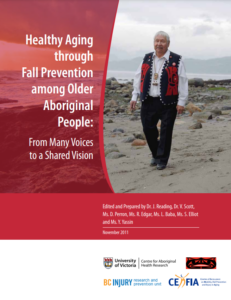
The Centre for Aboriginal Health Research, the Centre of Excellence on Mobility, Fall Prevention and Injury in Aging, the BC Injury Research and Prevention Unit, the BC Seniors Secretariat, and the University of Victoria Centre on Aging hosted a two-day symposium exploring the elements of an Aboriginal approach to Fall Prevention. The following report summarizes the agenda and rationale for the Symposium, the role of knowledge translation, key themes and emerging discussions, information generated, and suggestions for the next steps for creating an Aboriginal approach to fall prevention.
-
Indigenous Fall Prevention Symposium Report to the Public Health Agency of Canada (2018)
This report, prepared by Dr. Vicky Scott, presents the Indigenous Fall Prevention Symposium’s findings and recommendations to the Public Health Agency of Canada.
-
Injury in Review, 2020 Edition: Spotlight on Traumatic Brain Injuries across the Life Course
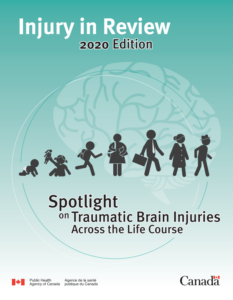
This report provides national surveillance statistics on head injuries and traumatic brain injuries across the life course, including deaths, hospitalizations and emergency department visits, using data sources including the Canadian Vital Statistics Death Database of Statistics Canada; the Hospital Morbidity Database and Discharge Abstract Database of the Canadian Institute for Health Information (CIHI); the National Ambulatory Care Reporting System of CIHI; and the Electronic Canadian Hospitals Injury Reporting and Prevention Program database (eCHIRPP).
4.23 MB PDF
-
Long-term Care Best Practices Toolkit (2nd edition, 2018): Fall Prevention and Management
The following resource is designed to assist Long-Term Care (LTC) homes with the implementation of the Prevention of Falls and Fall Injuries in the Older Adult Best Practice Guideline. Provided by the Registered Nurses’ Association of Ontario.
-
Re-shaping the Housing Market for Aging in Place and Home Modifications (2017)
-
Reducing Falls and Injuries from Falls Getting Started Kit
The Falls GSK was developed as part of the Canadian Patient Safety Institute’s signature program, Safer Healthcare Now! The Falls GSK was developed to engage interdisciplinary teams in a dynamic approach for improving quality and safety on the topic of falls prevention.
-
Seniors’ Falls in Canada (Second report, 2014)
-
Surveillance report on falls among older adults in Canada (2022)
Statistics
-
Dementia and falls – Canadian Institute for Health Information (2018)
This webpage from the Canadian Institute for Health Information (CIHI) provides a spotlight on data relating to falls among older adults with dementia.
-
Fact bank
Research
-
Canadian Centre for Activity and Aging – University of Western Ontario
The CCAA is a unique, national research and education centre within the Faculty of Health Sciences at Western. It promotes physical activity and well-being for older adults through a combination of basic and applied research, education, and community-based exercise programs. Its education and leadership training programs instruct thousands of individuals across Canada in standard, evidence-based practices to enhance the functional fitness of older adults at every level of mobility.
-
Centre for Aging SMART
The Centre for Aging SMART at Vancouver Coastal Health (VCH) is a University of British Columbia affiliated, internationally recognized research centre to accelerate discoveries and new knowledge to improve the lives of an aging population and individuals living with a disability.
-
Environmental interventions for preventing falls in older people living in the community
This review assesses the effects (benefits and harms) of environmental interventions (such as fall‐hazard reduction, assistive technology, home modifications, and education) for preventing falls in older people living in the community.
-
Exercise for Preventing Falls for Older People Living in the Community
This review assesses the effects (benefits and harms) of exercise interventions for preventing falls in older people living in the community.
-
Fall and injury prevention – Mc
Master Optimal Aging Portal Consult evidence-based blog posts, web resource ratings and evidence summaries for trustworthy information about health and social aspects of aging.
-
Interventions for preventing falls in older people in care facilities and hospitals
This review assesses the effects of interventions designed to reduce the incidence of falls in older people in care facilities and hospitals.
Guidelines
-
Promoting physical activity for older people: a toolkit for action (2023)
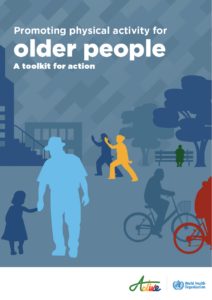
This World Health Organization toolkit provides evidence-based guidance on the key approaches to promote and enable older people to be physically active, regardless of who they are, where they live, or their intrinsic capacities (for example their visual or cognitive abilities) or whether they live with chronic conditions (for example, diabetes, hypertension, and arthritis).
-
Canadian 24-Hour Movement Guidelines for Adults ages 65 years and older: An Integration of Physical Activity, Sedentary Behaviour, and Sleep
This guideline offers clear direction on what a healthy 24 hours looks like for Canadian adults aged 65 years and older.
-
Clinical Best Practice Guidelines: Preventing Falls and Reducing Injury from Falls (Fourth Edition, 2017)
-
Clinical Practice Guideline for Management of Osteoporosis and Fracture Prevention (2023)
This guideline developed by Osteoporosis Canada provides recommendations on the diagnosis and management of osteoporosis. The guideline has 25 key recommendations and 10 good practice statements with emphasis on the areas of exercise, nutrition, fracture risk assessment, treatment and interventions.
-
Fracture Prevention Toolkit (in Long-Term Care)
The Ontario Osteoporosis Strategy for Long-Term Care is a province-wide program of outreach activities aimed at increasing awareness about fracture prevention, specifically in long-term care, with a focus on the importance of appropriate vitamin D and calcium intake, and on fall prevention. The toolkit contains valuable, practical information useful for healthcare professionals, caregivers and older adults living in long-term care homes and the community.
-
Hip fracture: Care for people with fragility fractures
This resource provides a guide for patients; a guide for clinicians; an information brief demonstrating why the quality standard is needed; quality improvement tools and resources; and performance indicators to help clinicians and organizations track their progress against the standard.
-
World Guidelines for Falls Prevention and Management for Older Adults: A Global Initiative
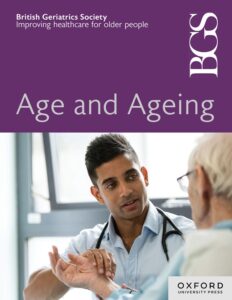
These guidelines were published in September 2022 in Age and Ageing, the scientific journal of the British Geriatrics Society. These guidelines were developed by the World Falls Task Force, which assembled 96 multidisciplinary experts from 39 countries across five continents, with representation from 36 scientific and academic societies.
Fact Sheets
-
Customizable ‘Staying Independent Checklist’ (2023)
Customize this Staying Independent Checklist by adding your organization’s logo and website details or leave it as is. The Staying Independent Checklist is a self-screening tool for older adults to find out if they are at risk for falling. Older adults are encouraged to complete the Checklist and to follow-up with their healthcare provider as needed.
1.50 MB Word
-
Occupational therapists on home modification teams
-
Occupational therapy and fall prevention
